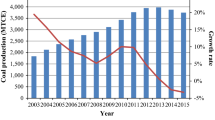Abstract
The paper first divides control rights of critical resources into government macroeconomic regulation power and insider control power for the management. After the discussion of the current status of Chinese coal industry integration, the paper mathematically and empirically analyzes influences of the government and state owned enterprises’ management to ownership’s boundary, and suggests the optimal ownership in different cases. The contributions of the paper are as follows: (1) Based on incomplete contract theory, the paper builds two mathematical models -the model of management’s investment level of relationship-specific human capital and ownership boundary model demonstrating the government utility under different ownership cases; (2) With the application of numerical simulation and empirical test, the paper analyzes impacts on coal resource integration from the aspects of government regulation and insider control, and discusses the optimal option of ownerships. By the analysis of the control power and ownership boundary based on the models, the paper eventually raises the optimal option of ownership allocation.











Similar content being viewed by others
References
Robin, M., Helen, W.: Merger policy, entry, and entrepreneurship. Eur. Econ. Rev. 57, 23–38 (2013)
Lei, S., Tian-ming, G., Xin, C.: China’s coal policy since 1979: A brief overview. Energy Policy 40, 274–281 (2012)
Shen, L., Gao, T.M., Cheng, X.: China’s coal policy since 1979: A brief overview. Energy Policy 40, 274–281 (2012)
Ginka, B., Paul, B., Jesus, M.S., Andrey, Z.: Government ownership and corporate governance: evidence from the EU. J. Bank. Financ. 36, 2917–2934 (2012)
Young-Sam, K., Byung-Yeon, K.: Ownership structure and firm performance: evidence from the Chinese corporate reform. China Econ. Rev. 23, 471–481 (2012)
Carsten, S.: The choice of ownership structure: Evidence from Russian mass privatization. J. Comp. Econ. 39, 260–277 (2011)
Munirul, H.N., Xuan, N., Pasquale, M.S., Chi-chur, C.: Strategic quality competition, mixed oligopoly and privatization. Int. Rev. Econ. Financ. 34, 142–150 (2014)
Isaac, M., Ike, M.: Privatization, financial development, property rights and growth. J. Bank. Financ. 50, 528–546 (2015)
Hart, O.: Incomplete contracts and public ownership remarks, and an application to public-private partnerships. Econ. J. 113(486), 69–76 (2003)
Charles, J.P.C., Jun, D., Xijia, S.: A game of accounting numbers in asset pricing: Evidence from the privatization of state-owned enterprises. J. Contemp. Acc. Econ. 10, 115–129 (2014)
Schmidt, K.: The costs and benefits of privatization: An incomplete contracts approach. J. Law Econ. Organ. 12(1), 1–24 (1996)
Raghuram, G.R., Luigi, Z.: Power in a theory of the firm. Q. J. Econ. 113(2), 387–432 (1998)
Toshihiko, M., Latchezar, P.: The political economy of entry barriers. Rev. Econ. Dyn. 17, 383–416 (2014)
Hart, O., Shleifer, A., Vishny, R.W.: The proper scope of government: Theory and an application to prisons. Q. J. Econ. 112(4), 1126–1161 (1997)
Djankov, S., La, P.R., Lopez-De-Silanes, F., Shleifer, A.: The regulation of entry. Q. J. Econ. 117(1), 1–37 (2002)
Fang, H., Sidney, C.M.L.: Top management turnover, firm performance and government control: evidence from China’s listed state-owned enterprises. Int. J. Acc. 47, 235–262 (2012)
Chen, L., Sonia, M.W.: Government intervention and firm investment: Evidence from international micro-data. J. Int. Money Financ. 32, 637–653 (2013)
Shao, Y.Y., Rodrigo, H., Liu, P.: Government intervention and corporate policies: Evidence from China. J. Bus. Res. 68, 1205–1215 (2015)
Xiang, L., Reza, S., Mohammad, B.: Institutional incentives and earnings quality: the influence of government ownership in China. J. Contemp. Acc. Econ. 10, 248–261 (2014)
Andrew, D., Smith, C.: SOEs in less developed countries: Privatization and alternative reform strategies. Eur. J. Law Econ. 12, 217–252 (2001)
King, S., Pitchford, R.: Private or public? A taxonomy of optimal ownership and management regimes. Econ. Res. J. 1, 41–47 (2008)
Huang, Q.H.: The control power as an incentive and constraint to entrepreneurs: a theoretical analysis and its practical significance. Econ. Rec. 84(266), 366–377 (2000)
Hoppe, I., Schmitz, P.W.: Public versus private ownership: quantity contracts and the allocation of investment tasks. J. Public Econ. 94(3), 258–268 (2010)
Acknowledgments
We thank for the support of The National Social Science Fund Project (12BGL044);the Education of Jiangsu Province “12th Five-Year Plan” Planning Issues (D/2013/01/007), the 2015 Graduate Education Reform Project of Jiangsu Province (JGZZ15_029), Xuzhou 2015 Soft Science Project(KC15RH117).
Author information
Authors and Affiliations
Corresponding author
Rights and permissions
About this article
Cite this article
Sun, Z., Zhu, Y., Li, Y. et al. Machine learning based control rights analysis of critical resources and the optimal ownership for management integration. Cluster Comput 19, 1925–1935 (2016). https://doi.org/10.1007/s10586-016-0660-z
Received:
Revised:
Accepted:
Published:
Issue Date:
DOI: https://doi.org/10.1007/s10586-016-0660-z




